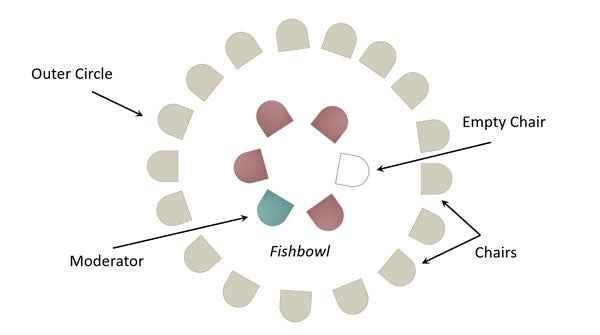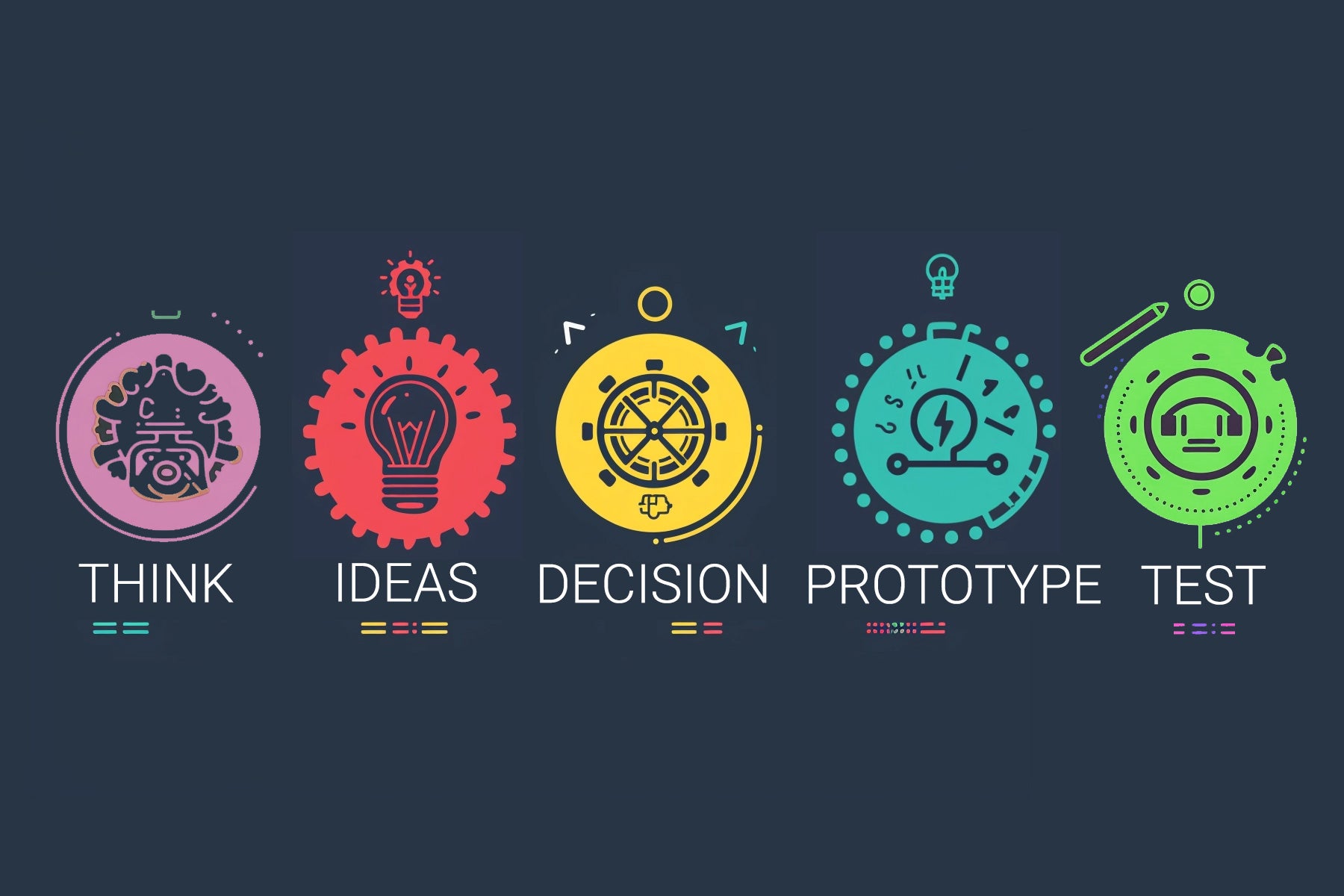Purpose
The fishbowl technique can be used to organise constructive discussions on a given topic. In a nutshell, the technique helps people manage a debate on the topic and keep it under control even if many people are participating. In this technique, at any given time, a group of people will be actively debating while the rest of the group listens in and takes notes of various viewpoints. Through an iterative process, many participants will get to listen and talk about a topic.
The fishbowl technique is ideal for many situations where a discussion around various points of view is needed. The technique is popular in political science, philosophy, advertising, science and decision making. It is also a great tool for training courses and involving students in various discussions around a specific topic.
The great advantage of the fishbowl technique is that it lessens the distinction between the speakers and the audience, while allowing many people to voice their views. It is ideal for large groups.
The fishbowl technique is particularly useful for today’s divisive societies where opposing views are constantly on a collision course. The technique helps to expose an audience to what the other camp thinks in a controlled manner and helps create a dialogue.
Objective
Apply the fishbowl conversation technique to get many people in a large group share their ideas about a given topic while keeping the discussion manageable and under control.
What You Need
- A large area. Place five or six chairs in a central area. Surround this with chairs in a circular fashion for the rest of the audience. All chairs look inward. You can have more than one outer circle if you have many participants. You may ask the outer most circle to stand, which helps to keep them engaged and actively listening.
- One chair in the centre is for a moderator and the rest is for participants who are considered to be in the fishbowl.
- Pick a topic with no obvious answers and lots of pros and cons for any given view point.
- Prepare a number of carefully constructed guided questions for this topic to use during the debate so you can help the participants cover all areas.
Setup
- Fishbowl technique doesn’t necessarily need a moderator, but using one is recommended. The moderator can sit in the central area but should not participate in the debate and instead focuses on making sure the debate runs smoothly and guides it.
- As the moderator, present the topic and provide any background to prepare the participants on what to discuss.
- Select four or five people and get them to sit in the centre. They will form the fishbowl and will be debating the topic. Ideally, these participants must be well-versed in the topic and be able to articulate their views well. This helps to give the debate a solid start aiming to set a high standard.
- Ask the participants in the fishbowl to actively discuss the topic. They will be providing logical arguments and demonstrating their knowledge about the topic.
- Participants in outer circles cannot participate in the discussions. They will be evaluating the arguments raised and reflect on new insights gained, especially when it comes from opposing viewpoints.
- Use your prepared guided questions to moderate the discussions. Only those in the fishbowl can participate in the discussions.
- The observers in outer circles can take notes on what is discussed and compose a critique or summary of the discussions. Some participants learn best when they observe while others might prefer to engage in discussions. As such, the fishbowl technique is designed to engage everyone.
- There are two main modes:
Open Fishbowl:
- In this mode, one chair in the centre is left empty. At any point during the discussion, any member of the audience in the outer circles can approach the centre and join the fishbowl. When a new person joins, a current member of the fishbowl must voluntarily leave which frees a chair. The discussion continues as participants enter and leave the fishbowl.
Closed Fishbowl:
- In this mode, all chairs are filled. The people in the fishbowl continue with the discussion until a pre-set timer runs out. At this point all members of the fishbowl leave to the outer circles and a new group from the audience enters the fishbowl. The discussion then continues. Iterate until many or all members have participated in the fishbowl.
- Time the session and keep it organised.
- Conclude a fishbowl session by summarising key points discussed.
Timing
Explaining the Exercise: 5 minutes
Activity: As needed
Group Feedback: As needed
Discussion
A fishbowl must be summarised with a discussion. It is easy to lose track of what has been covered. Many interesting and important points might be raised and if not captured can be easily lost. A summary will help everyone benefit from the session and also for future reference.
As a moderator, make sure you also ask participants about the effectiveness of the method and if any variations of the fishbowl conversation technique can help to improve discussing this field in the future.
Variations
Two-way Conversation
- This is a fishbowl with two opposing views. Only two chairs are placed in the fishbowl, both occupied. There could be a third chair for a moderator.
- When someone from the outer circles want to join the fishbowl, they must come forward and tap the shoulder of the person they want to replace when the person is not talking. The tapped person should then leave and the person replacing should carry on with the conversation.
- Continue as people join and leave the conversation.
Sub-Grouping
- This variation is ideal for group size of about ten.
- Split a group to two. You can divide based on a set parameter such as age, sex, experience or interest in something.
- Get them to discuss the topic and formulate a series of questions which will be asked from the other group. Ask them to write these questions on a series of separate cards.
- Bring the two groups together.
- Assign one group as the fishbowl and the other as the outer circle, listening in, but not participating in discussions.
- The group in the fishbowl should read through the question cards raised by the other group and discuss them. The outer circle should listen to answers and take notes on any evaluations.
- After a set time, swap the groups; the outer circle will now be the new fishbowl. Repeat the exercise with the new questions.
- Finish by collecting and summarising all discussions.
Online Learning
- The fishbowl technique is particularly useful for online learning, webcam sessions and live discussions. When you have many participants tuned in to a webinar, it can be difficult to manage a conversation between a lot of people. Here, you can create a fishbowl where five people can discuss a topic while all others listen and possibly see streaming videos. Periodically a member of the audience can enter the fishbowl and a person in the fishbowl leave it. The discussion then continues. You can set this up using dedicated software.
Soft Skills Training Materials
Get downloadable training materials
Online Train the Trainer Course:
Core Skills
Learn How to Become the Best Trainer in Your Field
All Tags
Training Resources for You

Course Design Strategy
Available as paperback and ebook

Free Training Resources
Download a free comprehensive training package including training guidelines, soft skills training activities, assessment forms and useful training resources that you can use to enhance your courses.

Our Comprehensive Guide to Body Language

Train the Trainer Resources
Get Insights - Read Guides and Books - Attend Courses
Training Materials
Get downloadable training materials on: Management Training, Personal Development, Interpersonal Development, Human Resources, and Sales & Marketing














Leave a comment
All comments are moderated before being published.
This site is protected by hCaptcha and the hCaptcha Privacy Policy and Terms of Service apply.